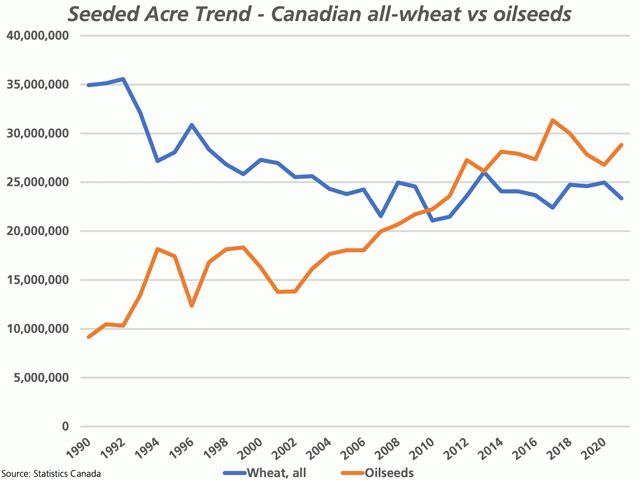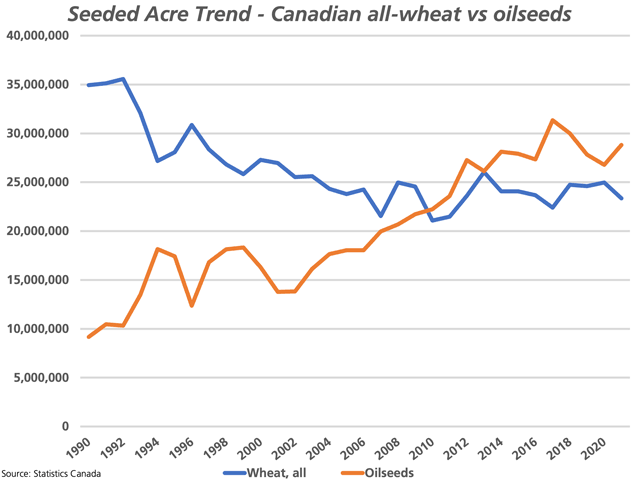Canada Markets
A Look at Statistics Canada's June Acreage Estimates
The June 29 Statistics Canada acreage report points to a swing in seeded acres from crops such as durum, barley, peas and oats; the largest adjustment in this report was a 949,100 acre increase in acres dedicated to canola, as expected in pre-report estimates.
When the year-over changes in total seeded acres are considered, acres are to jump by 187,000 from 2020 to 77.187 million acres (ma), while summerfallow acres are forecast to fall by 365,000 acres to 1.337 ma, the lowest seen in records going back to 1913. The reported increase in seeded acres does not correspond to the drop in summerfallow acres over this past year.
Canada's all-wheat acres were estimated at 23.357 ma, the smallest all-wheat acres seeded in four years, down 6.5% from 2020 and 3% below the five-year average.
When durum acres are removed from the equation, wheat acres (excluding durum) are pegged at 17.826 ma, very close to at least one of the pre-report estimates while down 7.6% from last year and the lowest acreage in four years. Based on AAFC's June assumptions, which includes average yield estimates, wheat production in 2021 would be 25.4 million metric tons (mmt), which is 400,000 mt higher than the current estimate released in June but down 3.2 mmt from 2020-21, signaling the need to curtail exports and stocks will remain tight.
Spring wheat acres are estimated at 16.477 ma, the smallest acres in four years. This is down 8.1% from last year and 3.9% below the five-year average. This is bullish for wheat when combined with the drought facing spring crops both in the U.S. and Canada. Hard red spring wheat acres account for 84.5% of the total spring wheat acres at 13.9202 ma, the smallest percentage reported in five years and only slightly below the five-year average of 86%.
P[L1] D[0x0] M[300x250] OOP[F] ADUNIT[] T[]
As expected in this week's pre-report estimates, Canada's durum acres were trimmed from the March intentions report. At 5.531 ma, acres are down 2.8% from last year and 1.5% below the five-year average. Based on current AAFC assumptions for 2021-22, production based on average yield would be 5.8 mmt, down close to 800,000 metric tons (mt) from the volume produced in 2020. Supplies could also tighten due to tighter carryout stocks, while demand will have to be rationed over the 2021-22 crop year.
Pre-report estimates appearing in media releases this week pointed to canola acres expected to be revised approximately 800,000 acres to 1 ma higher, which is exactly what was found in this report. Statistics Canada revised canola acres higher by 949,100 acres to 22.479 ma, up 1.696 ma or 8.2% from 2020 and the highest acres seeded in three years. Based on AAFC's current output estimates for 2021-22, production would rise roughly 1 mmt to 21 mmt in the crop year ahead, up sharply from the 18.7 mmt produced in 2020, although this forecast based on average yields will be challenged by weather.
As expected in pre-report estimates, barley acres were trimmed from the March intentions report to 8.296 million. This area remains up 9.7% or 734,800 acres from last year and is up 22.4% from the five-year average, while the largest area seeded since 2009. Based on AAFC estimates using average yields, production would increase to 11.5 mmt, although this is roughly 500,000 mt below their June estimate and signals that, despite the higher acreage, barley stocks for 2021-22 could remain close to this year's historic lows, especially if China maintains their current pace of imports.
Oat acres were estimated at 3.423 million, down 10.8% from last year and the smallest area seeded in three years. Based on AAFC forecasts, this could lead to production of approximately 4 mmt and growing stocks in 2021-22 from the tight levels forecast for 2020-21 will be close to impossible.
Dry pea acres were estimated at 3.820 million, close to the March intentions area. This is down 10.2% from last year and down 7.2% from the five-year average, the smallest area seeded in three years. Based on AAFC's assumptions, production would come close to the already forecast 3.950 mmt, while ending stocks are set to tighten in the crop year ahead.
Lentil acres were revised slightly higher in the June report, as expected, to 4.306 million. This is up 1.7% from last year and 1% below the five-year average. Given AAFC calculations, this could lead to production of 2.7 mmt, while again in 2021-22, stocks are forecast to draw down to pipeline levels.
Canada's corn acres were revised slightly lower from the March intentions report to 3.470 million, down 2.5% from last year and 3.8% from the five-year average. All major producing areas saw corn acres fall, with Quebec producers reducing acres by .6%, Ontario by 2% and Manitoba by 1.4%. While Ontario and Manitoba saw acres fall to the lowest level in 4 to 5 years, Quebec seeded the lowest area to corn seen since 1998, which bears further study.
Canada's soybean acres were estimated at 5.321 million, down slightly from the March estimate and close to the pre-report estimate. This area is up 4.9% from 2020 while is down 11.3% from the five-year average. This marks the first time in four years that acres have climbed higher year-over-year. Quebec boosted acreage by 4.5% in 2021, while the largest and most mature market of Ontario saw acres increase by 3%. The largest percentage increase was seen in Manitoba at 14.5% to 1.3 ma, also the first year-over-year increase reported in four years. Saskatchewan producers pared acres by one-third to 85,000 acres, the lowest seen since Statistics Canada began estimated the Saskatchewan crop in 2013.
Cliff Jamieson can be reached at cliff.jamieson@dtn.com
Follow him on Twitter @Cliff Jamieson
(c) Copyright 2021 DTN, LLC. All rights reserved.






Comments
To comment, please Log In or Join our Community .